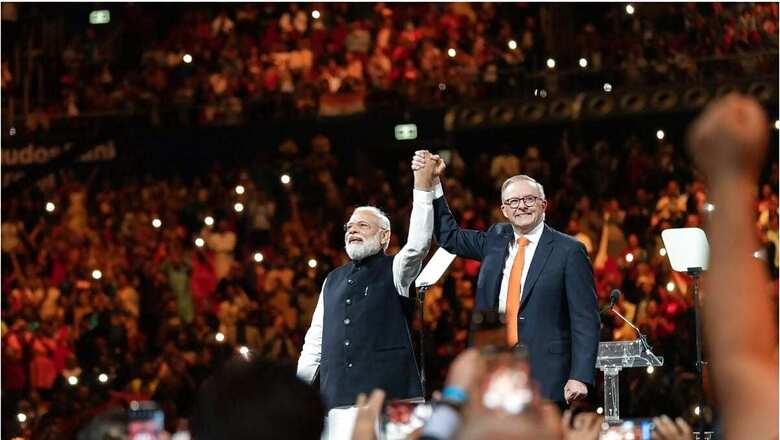
views
Yet another thunder of grand Narendra Modi gigs is rolling, this time in Australia. Raucous crowds of diaspora Indians, PM Anthony Albanese bringing out his surfboard to ride the Modi wave with a Bruce Springsteen analogy, live footage burning up the digital highways to every corner of the planet… it is all familiar clamour.
From a bleak broadcast booth submerged in this noise, PM Modi’s opponents and critics are trying to tell the world that this is all publicity-seeking, image-building, stage-managed PR event. They are bitter but not entirely wrong.
Yes, Modi is immensely popular both at home and overseas. And yes, he is a frightfully intuitive public relations genius. Both are true.
While Modi’s opponents accept his mastery over PR with disdain, one wonders if they privately and honestly analyse why he needed to be so good at that skill in the first place.
One can think of at least four very compelling reasons.
First, to counter decades of PR monopoly and the fusillade of self-promotion by the Gandhi family. It was almost unimaginable for a newcomer to even get his name recognised in the remotest corners of India where Chacha Nehru, Indira Mai and their progeny had long penetrated and cemented their place in popular mind space by relentless promotion. Radio, paper, posters, TV or names of schemes and parks and roads and events…the Nehru-Gandhis were everywhere.
A 2013 RTI query found that 450 schemes, projects and institutions were named after just three members of the Nehru-Gandhi family: Indira, Sanjay and Rajiv. Among those were central and state schemes, sports tournaments and trophies, stadiums, airports and ports, educational places, awards, fellowships, sanctuaries and national parks, hospitals and medical institutions, chairs, festivals, roads, buildings and other public spaces.
The family had given itself Bharat Ratna while one was alive, changed dates of Children’s Day to coincide with one’s birthday, held supreme sway over national media, and passed on the baton of power around the dinner table.
A challenger needed to be extraordinarily adept at PR warfare to take on the brand the dynasty had created over seven decades, spending something like an empire’s treasury.
Second, Modi today is the target of relentless character assassination attacks carried out or funded from abroad by anti-India interests. Global political meddler and billionaire George Soros has openly announced a bounty on Modi’s democratic mandate. Parts of the Western establishment and Deep State which wants a more pliable Indian government has been sponsoring regime change attempts through ‘peaceful’ non-state actors like NGOs, awards and grants. The Chinese Communist Party wants the stubbornly nationalistic Modi out, Pakistan’s jihad-military complex wants him dead or at least maligned every day. Certain nations like Turkey, Qatar, Morocco, Germany, and Canada have become hosts to anti-India plotters and IT cells.
To resist that multi-front barrage, Modi needs his shadow to loom much bigger than him when he walks. Amplification of his work and message on media and social media is what gives his image look so much bigger than his frame.
Third, India needs PR. An economy which was USD .94 trillion in 2006 has more than tripled to USD 3.2 trillion in 2021; in just 15 years. From an overwhelming cash economy, it has pivoted itself to being the world’s largest digital payments ecosystem. India is, today, tipped by almost all top financial agencies as the fastest-growing major economy.
Who will tell India’s story? Modi does. And for a nervous West or the indifferent rest to listen, the PM needs an Earth-size projector.
And fourth, Narendra Modi’s told and untold promise is not just to occupy the PM’s chair. His pledge is to change the course of history, not just wade in power.
He understands that in India, that cannot be achieved just by being a backroom boy. To hurtle towards the future on the wheels of its civilisational revival, a new Bharat will need new icons, new heroes, new lore, and a widely recognised and revered new sarathi or charioteer.
And Modi — who otherwise remained a quiet, wandering RSS pracharak for decades — realised early that the sarathi would need a loud and famed conch shell. Perhaps a lesson from Lord Krishna’s own Panchajanya, which carried its master’s message far and wide.
Abhijit Majumder is a senior journalist. Views expressed are personal.




















Comments
0 comment